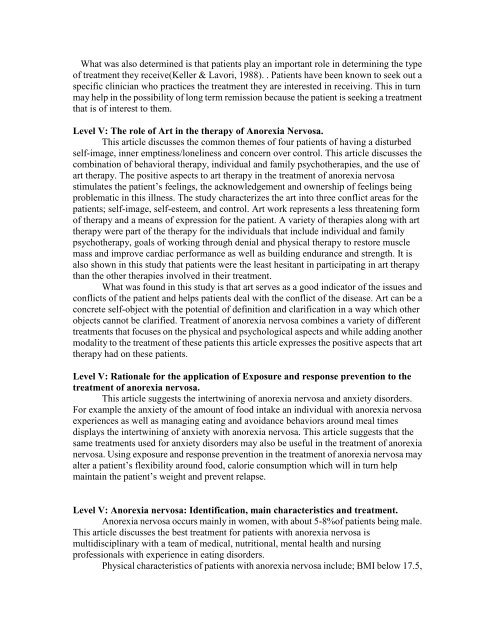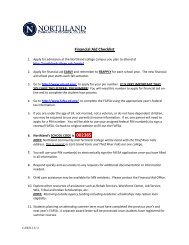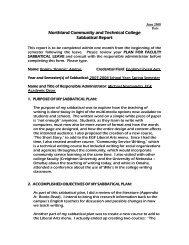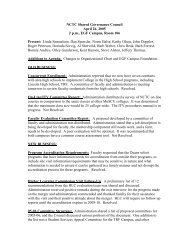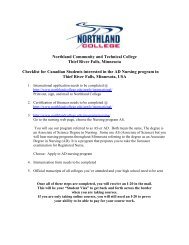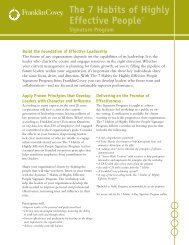OT's Role in Treatment of Anorexia Nervosa by Jessica Brown
OT's Role in Treatment of Anorexia Nervosa by Jessica Brown
OT's Role in Treatment of Anorexia Nervosa by Jessica Brown
You also want an ePaper? Increase the reach of your titles
YUMPU automatically turns print PDFs into web optimized ePapers that Google loves.
What was also determ<strong>in</strong>ed is that patients play an important role <strong>in</strong> determ<strong>in</strong><strong>in</strong>g the type<strong>of</strong> treatment they receive(Keller & Lavori, 1988). . Patients have been known to seek out aspecific cl<strong>in</strong>ician who practices the treatment they are <strong>in</strong>terested <strong>in</strong> receiv<strong>in</strong>g. This <strong>in</strong> turnmay help <strong>in</strong> the possibility <strong>of</strong> long term remission because the patient is seek<strong>in</strong>g a treatmentthat is <strong>of</strong> <strong>in</strong>terest to them.Level V: The role <strong>of</strong> Art <strong>in</strong> the therapy <strong>of</strong> <strong>Anorexia</strong> <strong>Nervosa</strong>.This article discusses the common themes <strong>of</strong> four patients <strong>of</strong> hav<strong>in</strong>g a disturbedself-image, <strong>in</strong>ner empt<strong>in</strong>ess/lonel<strong>in</strong>ess and concern over control. This article discusses thecomb<strong>in</strong>ation <strong>of</strong> behavioral therapy, <strong>in</strong>dividual and family psychotherapies, and the use <strong>of</strong>art therapy. The positive aspects to art therapy <strong>in</strong> the treatment <strong>of</strong> anorexia nervosastimulates the patient’s feel<strong>in</strong>gs, the acknowledgement and ownership <strong>of</strong> feel<strong>in</strong>gs be<strong>in</strong>gproblematic <strong>in</strong> this illness. The study characterizes the art <strong>in</strong>to three conflict areas for thepatients; self-image, self-esteem, and control. Art work represents a less threaten<strong>in</strong>g form<strong>of</strong> therapy and a means <strong>of</strong> expression for the patient. A variety <strong>of</strong> therapies along with arttherapy were part <strong>of</strong> the therapy for the <strong>in</strong>dividuals that <strong>in</strong>clude <strong>in</strong>dividual and familypsychotherapy, goals <strong>of</strong> work<strong>in</strong>g through denial and physical therapy to restore musclemass and improve cardiac performance as well as build<strong>in</strong>g endurance and strength. It isalso shown <strong>in</strong> this study that patients were the least hesitant <strong>in</strong> participat<strong>in</strong>g <strong>in</strong> art therapythan the other therapies <strong>in</strong>volved <strong>in</strong> their treatment.What was found <strong>in</strong> this study is that art serves as a good <strong>in</strong>dicator <strong>of</strong> the issues andconflicts <strong>of</strong> the patient and helps patients deal with the conflict <strong>of</strong> the disease. Art can be aconcrete self-object with the potential <strong>of</strong> def<strong>in</strong>ition and clarification <strong>in</strong> a way which otherobjects cannot be clarified. <strong>Treatment</strong> <strong>of</strong> anorexia nervosa comb<strong>in</strong>es a variety <strong>of</strong> differenttreatments that focuses on the physical and psychological aspects and while add<strong>in</strong>g anothermodality to the treatment <strong>of</strong> these patients this article expresses the positive aspects that arttherapy had on these patients.Level V: Rationale for the application <strong>of</strong> Exposure and response prevention to thetreatment <strong>of</strong> anorexia nervosa.This article suggests the <strong>in</strong>tertw<strong>in</strong><strong>in</strong>g <strong>of</strong> anorexia nervosa and anxiety disorders.For example the anxiety <strong>of</strong> the amount <strong>of</strong> food <strong>in</strong>take an <strong>in</strong>dividual with anorexia nervosaexperiences as well as manag<strong>in</strong>g eat<strong>in</strong>g and avoidance behaviors around meal timesdisplays the <strong>in</strong>tertw<strong>in</strong><strong>in</strong>g <strong>of</strong> anxiety with anorexia nervosa. This article suggests that thesame treatments used for anxiety disorders may also be useful <strong>in</strong> the treatment <strong>of</strong> anorexianervosa. Us<strong>in</strong>g exposure and response prevention <strong>in</strong> the treatment <strong>of</strong> anorexia nervosa mayalter a patient’s flexibility around food, calorie consumption which will <strong>in</strong> turn helpma<strong>in</strong>ta<strong>in</strong> the patient’s weight and prevent relapse.Level V: <strong>Anorexia</strong> nervosa: Identification, ma<strong>in</strong> characteristics and treatment.<strong>Anorexia</strong> nervosa occurs ma<strong>in</strong>ly <strong>in</strong> women, with about 5-8%<strong>of</strong> patients be<strong>in</strong>g male.This article discusses the best treatment for patients with anorexia nervosa ismultidiscipl<strong>in</strong>ary with a team <strong>of</strong> medical, nutritional, mental health and nurs<strong>in</strong>gpr<strong>of</strong>essionals with experience <strong>in</strong> eat<strong>in</strong>g disorders.Physical characteristics <strong>of</strong> patients with anorexia nervosa <strong>in</strong>clude; BMI below 17.5,


